| Back Number | No.20 2005/07/20 | |||
| News | The Number of EXPO 2005 Visitors Surpass 10 Million |  |
||
| Pavilions | Central America Pavilion (Global Common 2) Cuba Pavilion (Global Common 2) Dominican Pavilion (Global Common 2) |
|||
| Column | Aspects of EXPO 2005 for Children | |||
|
The Japan Association for the 2005 World Exposition announced on July 4 that the total number of visitors to EXPO 2005 Aichi, Japan exceeded 10 million at around 10:45am that day. This means that the two-thirds of the target figure of 15 million visitors to EXPO 2005 has been achieved at an early stage -102 days into the 185-day EXPO. More than 5 million of the tickets sold in advance have yet to be used, an indication that the total number of visitors will ultimately greatly exceed the target figure. |
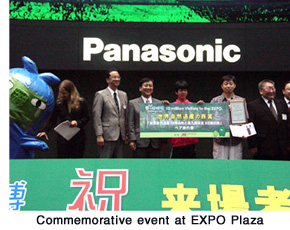 A commemorative event was held in the afternoon of July 4, and 10 visitors from among those who had arrived by 2:00pm were chosen by drawing to receive gifts such as admission tickets for two to EXPO 2005 and priority admission passes to various pavilions. Furthermore, a drawing was held to choose one person from among the 10 lucky winners to receive a commemorative diamond (roughly 2 carats) from the Russian Federation’s Republic of Sakha (Yakutia) where the Yukagir Mammoth - a main attraction of the EXPO - was excavated.
A commemorative event was held in the afternoon of July 4, and 10 visitors from among those who had arrived by 2:00pm were chosen by drawing to receive gifts such as admission tickets for two to EXPO 2005 and priority admission passes to various pavilions. Furthermore, a drawing was held to choose one person from among the 10 lucky winners to receive a commemorative diamond (roughly 2 carats) from the Russian Federation’s Republic of Sakha (Yakutia) where the Yukagir Mammoth - a main attraction of the EXPO - was excavated.Although attendance to EXPO 2005 was initially sluggish, on-going, daily efforts made by the Japan Association for the 2005 World Exposition to upgrade operations and increase the number of visitors by listening to visitor comments, such as improving the advance reservation system and visit routes, proved their worth and lead to the later better-than-expected number of visitors. Toshio Nakamura, Secretary-General of the Japan Association for the 2005 World Exposition said, on this day, “We are into the second half of the EXPO. With the summer vacation period coming up, we especially want to continue emphasizing operating a safe and comfortable world exposition each day, strive to make improvements and expend all possible means to provide even better services to visitors.” With summer vacation coming up, the association says that it wants to further enrich late-afternoon events and strive to level out the hours during which visitors attend EXPO 2005. There are now less than 70 days left to the EXPO. The total number of visitors as of July 20, 11:00am was 11,826,315. An even greater number of visitors are expected from the end of July when children will be on vacation from school. There is focus now being directed on how many people EXPO 2005 will ultimately attract. |
![]()
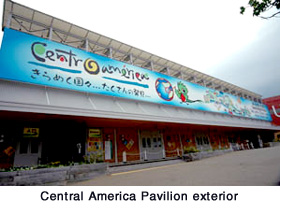 Central America is situated on an isthmus that connects North and South America. The region, surrounded by clear seas full of beautiful coral reefs, is known for ancient ruins hidden away in jungles and beautiful cathedrals built in a fusion of European and Central American styles. Central America also has rich forests, home to 8% of the world’s creatures despite the fact that the forests stand in an area that accounts for only 0.5% of the world’s land. There is also a wide spectrum of arts and crafts here including weaving and pottery. The wealth of diversity in nature, culture and the arts is a result of the region’s being a biological corridor, a place where people and nature pass through and interchange freely.
Central America is situated on an isthmus that connects North and South America. The region, surrounded by clear seas full of beautiful coral reefs, is known for ancient ruins hidden away in jungles and beautiful cathedrals built in a fusion of European and Central American styles. Central America also has rich forests, home to 8% of the world’s creatures despite the fact that the forests stand in an area that accounts for only 0.5% of the world’s land. There is also a wide spectrum of arts and crafts here including weaving and pottery. The wealth of diversity in nature, culture and the arts is a result of the region’s being a biological corridor, a place where people and nature pass through and interchange freely.The Central America Pavilion is a joint exhibition by Belize, the Republic of Costa Rica, the Republic of El Salvador, the Republic of Guatemala, the Republic of Honduras, the Republic of Nicaragua and the Republic of Panama. The theme of this joint pavilion is “Central America, so small, so big.” It is a pavilion where visitors can fully enjoy the charm of Central America. Central America is surrounded by three oceans: the Pacific, Atlantic and Caribbean. Each of the countries in the region has a very long coastline. It is at the pavilion’s “Seas of Central America and the Panama Canal” zone that you will be able to experience the beaches that dot the region. You will find a map of Central America on the floor upon which waist-high containers filled with real sand from the beaches of each of the seven countries are placed on their respective places on the map. The distinct differences in the sand become very apparent when you look at and touch the sand. The sand from Guatemala is black because it contains volcanic rock, while Belize, which boasts the Belize Barrier Reef that is the world's second largest coral reef, has white sand. The fineness of the sand also differs from beach to beach. It is a popular zone where visitors can experience Central America through the sense of touch. The footage of the Panama Canal, which connects the Pacific with the Atlantic, is also quite interesting. |
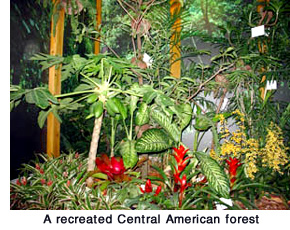 The next zone is named “Central American forests are the best in the world!” It is a recreation of the rainforests, cloud forests and tropical dry forests of Central America through exhibits of real trees, flowers and other plants. Also on exhibit are dynamic videos and colorful photographs of the diversity of the region's flora and fauna, such as the Quetzal, said to be the most beautiful bird in the world with an overall length of close to 1 meter; the Megasoma beetle which is the world's heaviest beetle; and Cattleya skinneri, a beautiful orchid that grows on trees in the forest.
The next zone is named “Central American forests are the best in the world!” It is a recreation of the rainforests, cloud forests and tropical dry forests of Central America through exhibits of real trees, flowers and other plants. Also on exhibit are dynamic videos and colorful photographs of the diversity of the region's flora and fauna, such as the Quetzal, said to be the most beautiful bird in the world with an overall length of close to 1 meter; the Megasoma beetle which is the world's heaviest beetle; and Cattleya skinneri, a beautiful orchid that grows on trees in the forest. |
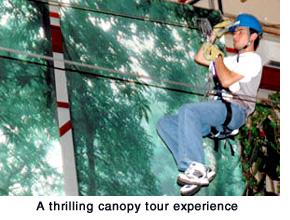 This is followed by the “Protecting the forests of Central America” zone which introduces eco-tourism and other activities being pursued by the countries of Central America in order to protect forests in the region. The canopy tour is a popular eco-tourism activity being promoted in Costa Rica and spreading to other parts of Central America. In a canopy tour, participants glide from tree to tree and platform to platform utilizing horizontal cables, harnesses and pulleys. It was used by biologists to observe plants and animals living in treetops. You can enjoy a bit of the thrills of a canopy tour at this joint pavilion.
This is followed by the “Protecting the forests of Central America” zone which introduces eco-tourism and other activities being pursued by the countries of Central America in order to protect forests in the region. The canopy tour is a popular eco-tourism activity being promoted in Costa Rica and spreading to other parts of Central America. In a canopy tour, participants glide from tree to tree and platform to platform utilizing horizontal cables, harnesses and pulleys. It was used by biologists to observe plants and animals living in treetops. You can enjoy a bit of the thrills of a canopy tour at this joint pavilion. |
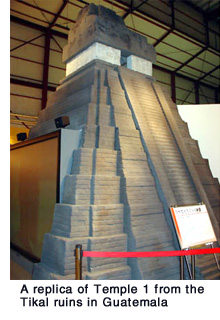 Central America is a region with a rich history of ancient civilization. A characteristic of the ancient civilization of the area covered by this pavilion is that it has been influenced by Mesoamerican civilizations, such as the Maya and Aztec civilizations to the north, and Andean civilizations, such as the Inca, to the south.
Central America is a region with a rich history of ancient civilization. A characteristic of the ancient civilization of the area covered by this pavilion is that it has been influenced by Mesoamerican civilizations, such as the Maya and Aztec civilizations to the north, and Andean civilizations, such as the Inca, to the south.The “Ancient civilization in Central America” zone features a pyramid fashioned after Temple 1 at the Tikal ruins in Guatemala, as well as other interesting exhibits including a stone monument with a Mayan inscription from the Maya Site of Copan of the Honduras, and it introduces the wisdom and technology of ancient peoples. The Indigo dyeing workshop enables you to experience such wisdom and technology through this traditional dye. We recommend a taste of the specialty coffee from growers in Central America at the end of your visit. August 19 is the Central America National Day. The countries exhibiting at this joint pavilion plan to introduce the tradition and culture of Central America through music, so be sure not to miss it! |
|
Cuba is an island nation situated on the western edge of the Caribbean Sea and at the entrance of the Gulf of Mexico. This country surrounded by beautiful coral reefs is also known as the stage of Earnest Hemingway’s novel, “The Old Man and the Sea.” Upon entering the Cuba Pavilion, visitors will find a colonial-style cityscape before them, featured by white walls and bright blue trimmings. It is a recreation of Old Havana, engraved on the World Heritage List in 1982. The buildings are characterized by high ceilings, large windows and balconies, a design that helps to invite cooling breezes to flow through and help people feel comfort in the hot heat. |
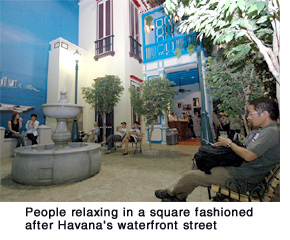 The pavilion contains a bar corner, and like La Bodeguita del Medio, a bar in Havana that Earnest Hemingway frequented, its walls are covered with messages left by customers. If you like, you can take your Cuban mango juice or rum-based cocktail and drink it in the adjacent square. The square, fashioned after the waterfront streets of Havana’s newer district, is a fitting place to rest your feet and quench your thirst, just as the citizens of Havana sit and seek the cooling ocean breeze today.
The pavilion contains a bar corner, and like La Bodeguita del Medio, a bar in Havana that Earnest Hemingway frequented, its walls are covered with messages left by customers. If you like, you can take your Cuban mango juice or rum-based cocktail and drink it in the adjacent square. The square, fashioned after the waterfront streets of Havana’s newer district, is a fitting place to rest your feet and quench your thirst, just as the citizens of Havana sit and seek the cooling ocean breeze today.A Salsa dance class held on Wednesdays, Fridays and Saturdays from 5pm at a multipurpose event space in the center of the pavilion is proving quite popular. The lessons start with very basic steps, so beginners can casually join in the fun and dance to the upbeat rhythm of the Salsa. |
|
Hispaniola Island, situated in the Caribbean Sea, was an island discovered by Christopher Columbus in 1492 during his first expedition. He was taken aback by the beauty of the island and is said to have written in his journal that this was “the most beautiful place the human eyes have seen.” The Dominican Republic occupies two thirds of the eastern portion of Hispaniola Island. The theme of the Dominican Pavilion is “Island Crystallized with Nature and History.” Important historical materials including replicas of the sailing vessels used by Columbus during his voyage and equipment for observing the stars salvaged from sunken ships from the Great Age of Discovery are on display. |
 The culture of the Dominican Republic is a fusion of the cultures of the indigenous population, the Europeans who settled on the island after Columbus’ voyage, and the people of Africa who were brought there as slaves. Merengue, a dance originating in this country that is danced to the beat of the Guiro, a Latin American percussion instrument, African drums and the melody of the European accordion, is one such example.
The culture of the Dominican Republic is a fusion of the cultures of the indigenous population, the Europeans who settled on the island after Columbus’ voyage, and the people of Africa who were brought there as slaves. Merengue, a dance originating in this country that is danced to the beat of the Guiro, a Latin American percussion instrument, African drums and the melody of the European accordion, is one such example.Merengue lessons are held at the Dominican Pavilion twice a day from 2:30pm and 5:30pm. It is a joyful time when visitors receiving instruction from the Dominican staff cannot help but catch the beaming smiles remindful of the Caribbean Sea shown by their teachers. By the time the lesson of roughly 30 minutes is over, participants are fully enchanted by the gay and hospitable charm of the people of the Dominican Republic. |
![]()
|
EXPO 2005 Aichi, Japan continues to provide various opportunities for encounters and experiences to the children, the future bearers of the 21st century. |
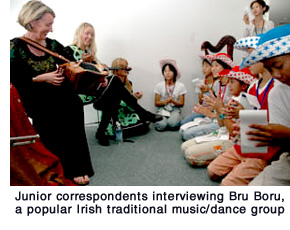 On July 13, sixth graders from Class 3 of Asahi Elementary School of Owari Asahi City, Aichi Prefecture got to experience something they will remember for a long time to come. They were on site at EXPO 2005 to collect materials as correspondents for the junior edition of the Yomiuri Global Newspaper and had a chance to publish their own newspaper.
On July 13, sixth graders from Class 3 of Asahi Elementary School of Owari Asahi City, Aichi Prefecture got to experience something they will remember for a long time to come. They were on site at EXPO 2005 to collect materials as correspondents for the junior edition of the Yomiuri Global Newspaper and had a chance to publish their own newspaper.The 29 children split up into two groups. 15 children interviewed Bru Boru, a popular Irish traditional music/dance group, at the Ireland Pavilion. The other 14 children visited the Italy Pavilion to ask the head of the Puglia Tourism Bureau about olives, a local specialty. After the interviews, the children proceeded to the editorial office located within the Global House and all went to work to write articles with the help of the editor-in-chief and three other full-fledged adult professionals. An A3 paper-size galley print was created based on these articles. The names of all the children were printed on one-half of the paper along with short articles as written by the children. The other half contained photographs and interview articles that summarized the children’s articles written by professional reporters who accompanied them. When proofreading of the galley prints were completed, it was time to write the headlines. Children submitted so many ideas that it filled the whole of the whiteboard where they were written, and the editor-in-chief selected those considered best. |
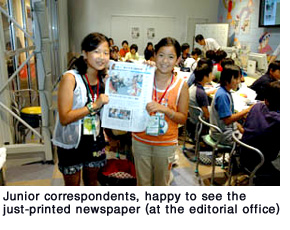 When they were handed copies of the just-printed newspaper, the junior correspondents’ faces beamed and they said, “We were a bit nervous at first, but covering these stories and making this newspaper was really a lot of fun.”
When they were handed copies of the just-printed newspaper, the junior correspondents’ faces beamed and they said, “We were a bit nervous at first, but covering these stories and making this newspaper was really a lot of fun.”This is a joint project between the Japan Association for the 2005 World Exposition and The Yomiuri Shimbun newspaper. They call upon elementary and middle school students nationwide to act as correspondents. More than 100 issues have been published, including those covering visits to EXPO 2005 by French President Jacques Chirac, Japanese Prime Minister Junichiro Koizumi and Shoichi Nakagawa, Minister of Economy, Trade and Industry. There is even a website sponsored by the Japan Association for the 2005 World Exposition, “School Project EXPO Go, Go!” that recruits children to participate in the EXPO. The purpose of this project is for the sharing and further deepening of the impressions and opinions of children who visit EXPO 2005, beyond schools and regions. It makes a public call upon elementary and middle schools nationwide planning field trips to EXPO 2005 Aichi, Japan. Visitors to the EXPO Go, Go! Website will find a forum for presentations. There is a wide array of not only articles but also photographs taken at the EXPO and other items. It gives you a clear indication of the discoveries made by children at the EXPO as well as their thoughts. The EXPO Go! Go! Website has two pages for children. The one intended for lower to middle elementary school grade children is the Questions and Surprises at EXPO 2005 page, while the other is the Yes/No about EXPO 2005 page for upper elementary school grade children to middle school students. One of the themes covered in the Questions and Surprises at EXPO 2005 page is “Surprises at EXPO 2005.” Visitors to this page will be able to see EXPO 2005 Aichi, Japan through the eyes of children. It includes cute pictures drawn by the children and is very heartwarming. In the Yes/No about EXPO 2005 page, children confidently state their opinions in response to the question, “Can world expositions coexist with nature?” which is one of the themes covered in the page. |
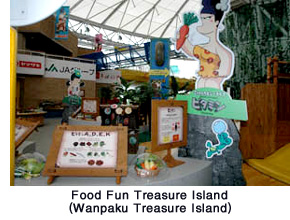 One of the features of EXPO 2005 is that there is a pavilion for elementary school students and families: Wanpaku Treasure Island. It features “Gon, the Stone-Age Boy,” a popular character, and his family who act as hosts of the pavilion exhibits.
One of the features of EXPO 2005 is that there is a pavilion for elementary school students and families: Wanpaku Treasure Island. It features “Gon, the Stone-Age Boy,” a popular character, and his family who act as hosts of the pavilion exhibits.The exhibits on the first floor is designed to help children and visitors learn about “food” while having fun. Gon’s Stomach Slide offers an experience about digestion, while the Watch with Gon! Vitality Discovery Theater provides footage related to food and health. There is also an exhibit about food and nutrients as well as the Amazing Food Gallery which teaches children about processed foods, including fermented foods. Many schools are visiting this pavilion as part of their enrichment programs. The second floor offers interactive programs that entertain visitors by providing lessons on themes such as food (cooking), animation and sports. The paper-making workshop that utilizes banana stalks is especially popular. The pavilion was originally expecting a total of a million visitors but more than 1.4 million have already visited the pavilion. Children who visit EXPO 2005 Aichi, Japan are, without a doubt, absorbing the wisdom of nature and humankind through this EXPO and growing as the future bearers of the 21st century. |
| EXPO 2005 AICHI, JAPAN Newsletter | |
| To read past issues:Back Number | |
| Editor/Publisher: Japan Association for
the 2005 World Exposition Head Office: 1533-1 Ibaragabasama, Nagakute-cho Aichi 480-1101 Japan Nagoya Office: Nagoya Daiya II Bldg 4F, 3-15-1 Meieki Nakamura-ku, Nagoya, Aichi 450-0002 Japan Tokyo Office: Iino Bldg 8F, 2-1-1 Uchisaiwai-cho Chiyoda-ku, Tokyo 100-0011 Japan |
 |
© Japan Association for the 2005 World Exposition
